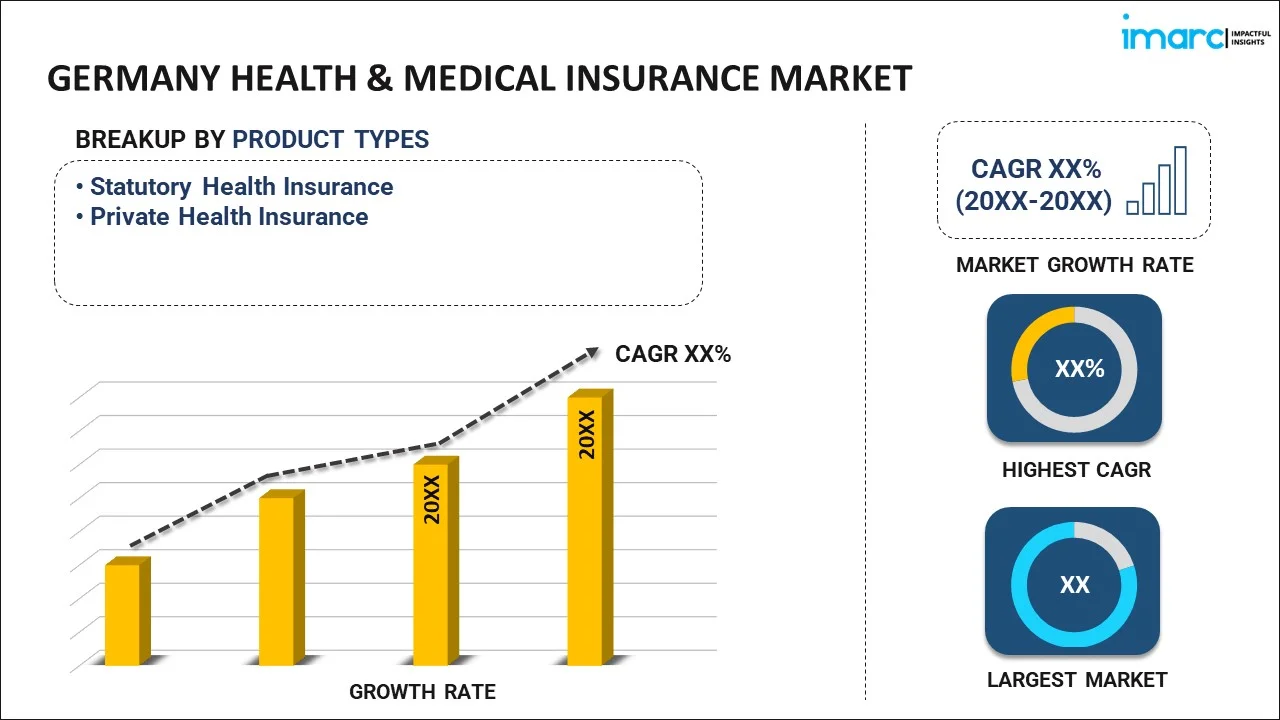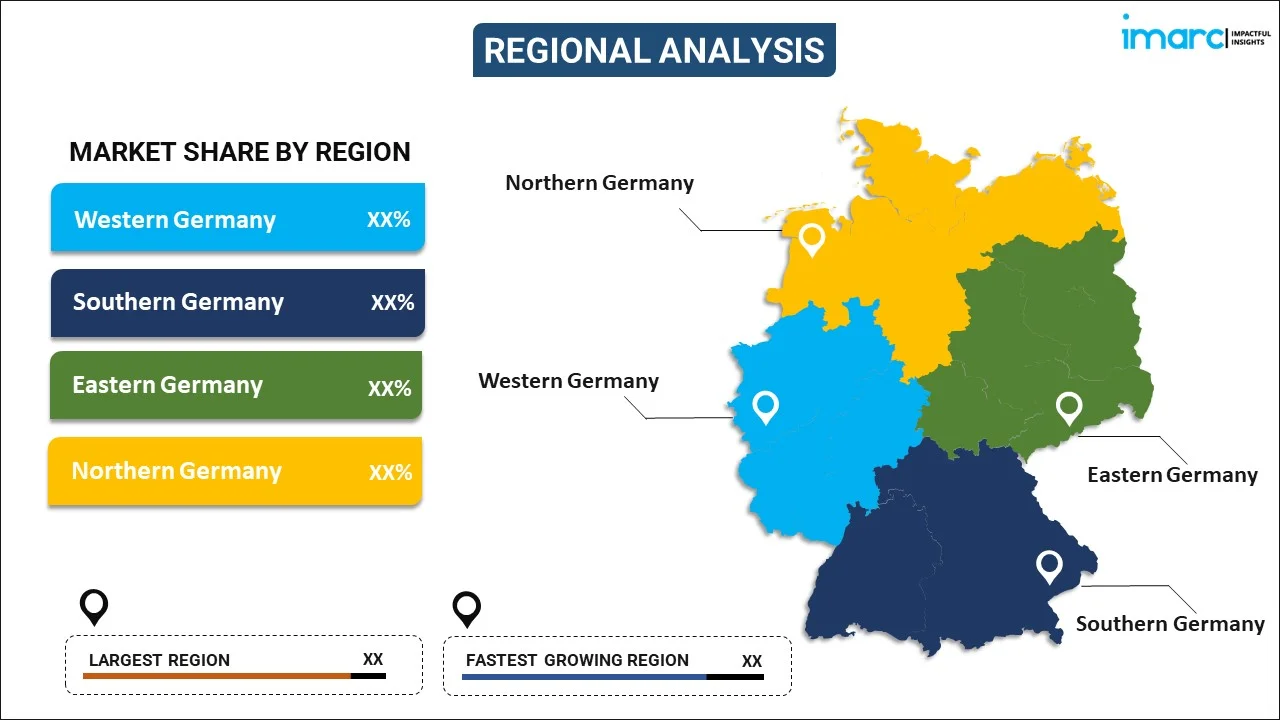
Germany Health & Medical Insurance Market Report by Product Type (Statutory Health Insurance, Private Health Insurance), Term of Coverage (Short-term, Long-term), Channel of Distribution (Single Tied or Insurance Group Intermediaries, Broker and Multiple Agents, Credit Institutions, Direct Selling, and Others), Income Level (Employed Annual Income < EUR 64,350, Employed Annual Income > EUR 64,350, Self-employed, Civil Servants), and Region 2025-2033
Germany Health & Medical Insurance Market Overview:
The Germany health & medical insurance market size is projected to exhibit a growth rate (CAGR) of 5.95% during 2025-2033. The expansion of private health insurance, growing demand for comprehensive coverage, supportive government policies, advancements in medical technology, increasing awareness of health issues, rising healthcare costs, and growing aging population are some of the major factors driving the growth of the market.
|
Report Attribute
|
Key Statistics
|
|---|---|
|
Base Year
|
2024 |
|
Forecast Years
|
2025-2033
|
|
Historical Years
|
2019-2024
|
| Market Growth Rate (2025-2033) | 5.95% |
Germany Health & Medical Insurance Market Trends:
Rising Aging Population
Germany's aging demographic increases demand for health and medical insurance, as older individuals typically require more healthcare services and coverage. According to industry reports, Germany’s population age 65 years and older is projected to grow by 41%, reaching 24 million by 2050 and accounting for nearly one-third of the total population. Meanwhile, the population aged 15 to 64 is projected to decrease by 23%, from about 53 million in 2015 to around 41 million by 2050. In Germany, the super-aged population enjoys a high healthy life expectancy, with three-quarters of individuals aged 65 and older reporting that they still feel fit.
Increasing Government Regulations and Policies
Supportive government policies and regulations, including mandatory health insurance, ensure a broad base of insured individuals, thereby bolstering the market. For instance, starting from January 1, 2024, statutory health insurance contributions in Germany increased by 0.1 percentage points. This means that health insurance contributions are now as high as 1.7%. The decision has been announced by the Federal Minister of Health, Karl Lauterbach, in a bid of the same to close the approximately €17 billion deficit which is expected in 2024. Finance Minister Christian Lindner emphasized that tax subsidies to statutory health insurance cannot be increased, leading to the necessity of this slight contribution rate rise. Lauterbach reassured that there will be no reductions in benefits and highlighted that the minimal increase is a positive step to bolster trust in social security systems. However, the 1.7% rate is not uniform across all insurance companies, as some may adjust their minimum contribution rates, according to Anne Klemm, board member of the umbrella association of company health insurance companies (BKK). Health insurance is mandatory for all residents in Germany, including foreigners. The country offers both public and private health insurance options, with public insurance available to employees below a certain income threshold and private insurance an option for higher earners or self-employed individuals.
Germany Health & Medical Insurance Market News:
- In January 2024, Allianz Partners announced the launch of the Allyz mobile app, a digital platform providing travelers with trusted advice and expertise as well as access to the full suite of insurance benefits available to customers. The launch of the mobile app in France, Germany, and the Netherlands is an important milestone in the expansion of Allianz Partners' digital platform, with the rollout of new digitally accessible services to continue across all lines of business until 2024.
- In June 2023, AXA rebranded its digital healthcare platform (DHP) which was launched in collaboration with Microsoft earlier, now as Healthanea. Delphine Icart, CEO of Healthanea, shares the ambition behind the new company, which wants to change the collaboration model in healthcare.
Germany Health & Medical Insurance Market Segmentation:
IMARC Group provides an analysis of the key trends in each segment of the market, along with forecasts at the country level for 2025-2033. Our report has categorized the market based on product type, term of coverage, channel of distribution, and income level.
Product Type Insights:

- Statutory Health Insurance
- Private Health Insurance
The report has provided a detailed breakup and analysis of the market based on the product type. This includes statutory health insurance and private health insurance.
Term of Coverage Insights:
- Short-term
- Long-term
A detailed breakup and analysis of the market based on the term of coverage have also been provided in the report. This includes short-term and long-term.
Channel of Distribution Insights:
- Single Tied or Insurance Group Intermediaries
- Broker and Multiple Agents
- Credit Institutions
- Direct Selling
- Others
A detailed breakup and analysis of the market based on the channel of distribution have also been provided in the report. This includes single tied or insurance group intermediaries, broker and multiple agents, credit institutions, direct selling, and others.
Income Level Insights:
- Employed Annual Income < EUR 64,350
- Employed Annual Income > EUR 64,350
- Self-employed
- Civil Servants
A detailed breakup and analysis of the market based on the income level have also been provided in the report. This includes employed annual income < EUR 64,350, employed annual income > EUR 64,350, self-employed, and civil servants.
Regional Insights:

- Western Germany
- Southern Germany
- Eastern Germany
- Northern Germany
The report has also provided a comprehensive analysis of all the major regional markets, which include Western Germany, Southern Germany, Eastern Germany, and Northern Germany.
Competitive Landscape:
The market research report has also provided a comprehensive analysis of the competitive landscape. Competitive analysis such as market structure, key player positioning, top winning strategies, competitive dashboard, and company evaluation quadrant has been covered in the report. Also, detailed profiles of all major companies have been provided.
Germany Health & Medical Insurance Market Report Coverage:
| Report Features | Details |
|---|---|
| Base Year of the Analysis | 2024 |
| Historical Period | 2019-2024 |
| Forecast Period | 2025-2033 |
| Units | Billion USD |
| Scope of the Report | Exploration of Historical Trends and Market Outlook, Industry Catalysts and Challenges, Segment-Wise Historical and Future Market Assessment:
|
| Product Types Covered | Statutory Health Insurance, Private Health Insurance |
| Term of Coverages Covered | Short-term, Long-term |
| Channel of Distributions Covered | Single Tied or Insurance Group Intermediaries, Broker and Multiple Agents, Credit Institutions, Direct Selling, Others |
| Income Levels Covered | Employed Annual Income < EUR 64,350, Employed Annual Income > EUR 64,350, Self-employed, Civil Servants |
| Regions Covered | Western Germany, Southern Germany, Eastern Germany, Northern Germany |
| Customization Scope | 10% Free Customization |
| Post-Sale Analyst Support | 10-12 Weeks |
| Delivery Format | PDF and Excel through Email (We can also provide the editable version of the report in PPT/Word format on special request) |
Key Questions Answered in This Report:
- How has the Germany health & medical insurance market performed so far and how will it perform in the coming years?
- What has been the impact of COVID-19 on the Germany health & medical insurance market?
- What is the breakup of the Germany health & medical insurance market on the basis of product type?
- What is the breakup of the Germany health & medical insurance market on the basis of term of coverage?
- What is the breakup of the Germany health & medical insurance market on the basis of channel of distribution?
- What is the breakup of the Germany health & medical insurance market on the basis of income level?
- What are the various stages in the value chain of the Germany health & medical insurance market?
- What are the key driving factors and challenges in the Germany health & medical insurance?
- What is the structure of the Germany health & medical insurance market and who are the key players?
- What is the degree of competition in the Germany health & medical insurance market?
Key Benefits for Stakeholders:
- IMARC’s industry report offers a comprehensive quantitative analysis of various market segments, historical and current market trends, market forecasts, and dynamics of the Germany health & medical insurance market from 2019-2033.
- The research report provides the latest information on the market drivers, challenges, and opportunities in the Germany health & medical insurance market.
- Porter's five forces analysis assist stakeholders in assessing the impact of new entrants, competitive rivalry, supplier power, buyer power, and the threat of substitution. It helps stakeholders to analyze the level of competition within the Germany health & medical insurance industry and its attractiveness.
- Competitive landscape allows stakeholders to understand their competitive environment and provides an insight into the current positions of key players in the market.
Need more help?
- Speak to our experienced analysts for insights on the current market scenarios.
- Include additional segments and countries to customize the report as per your requirement.
- Gain an unparalleled competitive advantage in your domain by understanding how to utilize the report and positively impacting your operations and revenue.
- For further assistance, please connect with our analysts.
 Inquire Before Buying
Inquire Before Buying
 Speak to an Analyst
Speak to an Analyst
 Request Brochure
Request Brochure
 Request Customization
Request Customization




.webp)




.webp)












